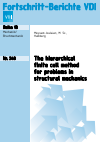The hierarchical finite cell method for problems in structural mechanics
Zusammenfassung
The finite cell method (FCM) is a combination of the fictitious domain approach and high-order finite elements. This thesis is concerned with the study of the numerical challenges of this method, and it investigates possible approaches to overcome them. Herein, we will introduce and study different numerical integration schemes, such as the adaptive integration method and the moment fitting approach. To improve the convergence behavior of the FCM for problems with heterogeneous material, we will also propose two high-order enrichment strategies based on the hp-d approach and the partition of unity method. Moreover, the application of the FCM will be extended to the simulation of wave propagation problems, employing spectral elements and a novel mass lumping technique.
...
Schlagworte
- I–X
- 1–4 1 Introduction 1–4
- 1.1 Motivation
- 1.2 Scope and outline of this work
- 5–26 2 Finite cell method for problems in solid mechanics 5–26
- 2.1 The strong and weak form of the governing equations
- 2.2 The finite element method
- 2.3 Mesh generation and the finite cell method
- 2.4 Numerical challenges of the finite cell method
- 2.4.1 Fast algorithms to introduce the indicator function
- 2.4.2 Imposition of boundary conditions
- 2.4.2.1 Neumann boundary conditions
- 2.4.2.2 Dirichlet boundary conditions
- 2.4.3 Numerical integration of cut cells
- 2.4.4 Material interfaces and weak discontinuities
- 2.4.5 Efficient iterative solvers
- 2.5 Some applications of the FCM
- 2.5.1 Elastostatic analysis of a one-dimensional rod
- 2.5.2 Perforated plate
- 2.5.3 Porous domain
- 27–71 3 Numerical integration algorithms for the FCM 27–71
- 3.1 Numerical integration of unbroken cells
- 3.2 Performance of Gaussian quadrature rules in facing discontinuities
- 3.3 Composed integration
- 3.3.1 Composed integration based on conforming local meshes
- 3.3.2 Composed integration based on uniform sub-cell division
- 3.3.3 Composed integration based on spacetrees
- 3.3.4 Resolution of the integration mesh
- 3.3.5 Composed integration with an hp-refinement procedure
- 3.4 Moment fitting method
- 3.4.1 Step 1: Selection of the basis functions
- 3.4.2 Step 2: Setting up the position of the quadrature points
- 3.4.3 Step 3: Computation of the right-hand side
- 3.4.3.1 Computing the right-hand side on B-rep models
- 3.4.3.2 Computing the right-hand side on voxel models
- 3.4.3.3 Computing the right-hand side on implicitly described geometries
- 3.4.4 Step 4: Solving the equation system
- 3.4.5 Recovery of the Gauss quadrature rule
- 3.5 Performance of the suggested numerical integration schemes
- 3.5.1 Cell cut by a planar surface
- 3.5.2 Cell cut by several planar surfaces
- 3.5.3 Cell cut by a curved surface
- 3.5.4 Cell cut by several curved surfaces
- 3.5.5 Numerical integration on voxel models
- 3.6 Performance of the numerical integration methods in the FCM
- 3.6.1 Perforated plate
- 3.6.2 Sphere under hydrostatic stress state
- 3.6.3 Porous domain under pressure
- 72–110 4 Local enrichment of the FCM 72–110
- 4.1 FCM for problems with material interfaces
- 4.2 Local refinement and adaptivity
- 4.3 Describing material interfaces using the level set function
- 4.3.1 Smooth level set functions
- 4.3.2 Non-smooth level set functions
- 4.4 Local enrichment with the aid of the PU method
- 4.4.1 Enrichment function for problems with material interfaces
- 4.4.1.1 Stable XFEM/GFEM
- 4.4.1.2 Blended enrichment
- 4.5 Local enrichment with the aid of the hp-d method
- 4.6 Selection of proper enrichment strategy
- 4.7 Numerical examples
- 4.7.1 Elastostatic analysis of a bi-material one-dimensional rod
- 4.7.2 Bi-material perforated plate with curved holes
- 4.7.3 Interplay between the fictitious domain and the enrichment zone
- 4.7.4 3D cube with cylindrical inclusion
- 4.7.5 Heterogeneous material
- 111–132 5 The spectral cell method 111–132
- 5.1 Temporal discretization and lumped mass matrix
- 5.2 Spectral cell method and mass lumping in cut cells
- 5.2.1 Row-sum technique for cut cells
- 5.2.2 Mass scaling technique
- 5.2.3 Diagonal scaling technique
- 5.3 Numerical examples
- 5.3.1 Lamb waves in a 2D plate
- 5.3.2 Lamb waves in a perforated plate
- 5.3.3 Lamb waves in a 2D porous plate
- 5.3.4 Wave propagation in a sandwich plate
- 133–135 6 Summary and Outlook 133–135
- 136–137 A Gaussian quadrature rules 136–137
- A.1 Gauss-Legendre quadrature
- A.2 Gauss-Legendre-Lobatto quadrature
- 138–138 B Polynomial integrands 138–138
- 139–139 C Chen-Babuška points 139–139
- 140–154 Bibliography 140–154


